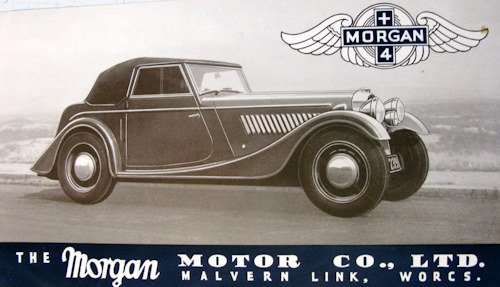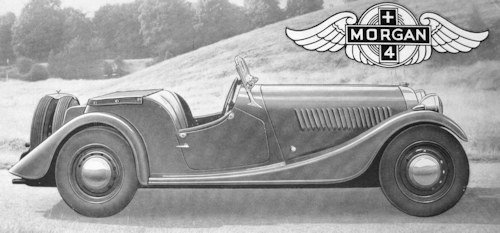Morgan Plus 4 (Standard Vanguard engine)
 |
|
|
Manufacturer |
Morgan Motor Company |
|
Production |
1950 to 1953 |
|
Assembly |
Malvern, Worcestershire, England |
|
Class |
Sports car |
|
Body style |
2-door convertible |
|
Layout |
Front mid-engine |
|
Engine |
2088 cc I4(Standard) |
|
Wheelbase |
96 in (2,438 mm) |
|
Length |
145 in (3,683 mm) |
|
Width |
56 in (1,422 mm) |
|
Height |
52 in (1,321 mm) |
|
Curb weight |
1,848 lb (838 kg) 1,848 lb (838 kg) (Super Sports) |
|
Related |
Morgan 4/4 Morgan Plus 8 |
The Morgan Plus 4 (or +4) that used in the Standard Vanguard engine is a larger and more powerful version of the Morgan Motor Company's 4/4 model and was made between 1950 and 1953.
History
After World War II Morgan had re-introduced their 4/4 model fitted with Standard Vanguard engine. This continued in production until 1950 when it was replaced by the larger Plus 4 announced at the 1950 Earl's Court Motor Show. In 1955 the 4/4 model re-appeared in phase II form.
This updated Plus 4 was at first fitted with a 2088 cc four-cylinder, overhead-valve engine.Based on that used in the Standard Vanguard fitted in a strengthened and longer chassis. Hydraulic brakes, at first all drum, were fitted for the first time on a Morgan as a coupe for £565 and the classic two seat for £510 in Black, BRG Green,Blue or red.
With an increase in maximum power of 70 per cent, and an added weight only 1 cwt by the adoption of a 2.1-litre Standard Vanguard engine in place of the 1-1/4 litre power unit that was also from Standard fitted to previous models. Apart from this there is little to distinguish the Plus Four model, in external appearance, from the 4/4 however, the changes go very much deeper than the mere substitution of one engine for larger size.
Although the distinctive basic layout remains unaltered, the entire chassis has been re-designed with the dual object of giving added sturdiness to withstand the higher
loads and of providing enhanced standards of comfort and handling with a slight increase in passenger accommodation. with slight modifications to the induction and cooling systems which do not affect the power output of bhp. The a car weighing approximately 14,5 cwt with moderately high gearing the top gear road speed of 76 mph they get up to 60 m.p.h. in 14 seconds and a top speed of 85 m.p.h.
The Morgan has independent front suspension of the type employing vertical springs and sliding axles. on the Plus Four model, the same system is employed except that the main coil springs are now 3 in. longer, to give greater wheel movement and a softer ride, whilst the geometry of the layout has been improved by inclining the assemblies at an angle of 2 degrees to the vertical. In addition, the Girling telescopic dampers are of a larger size than those previously used. With the sliding-axle type of front suspension, considerable importance attaches to adequate lubrication of the sliding members if the system is not to stiffen up in action. In the past, grease nipples have been relied upon as the means of lubrication but, on the new model, a semi-automatic arrangement has been adopted. The upper ends of the suspension spindles are connected by copper piping to a metered
two-way union adjacent to the dash, this union being connected via a pedal-operated valve to the pipe leading to the engine oil-pressure gauge. Thus, momentary pressure
on this pedal opens the valve and allows oil under the full engine pressure to flow into the pipes and thence to the suspension units.
In 1953 a higher performance version was announced with the 1991 cc I4 engine as used in the Triumph TR3. The radiator grille was now surrounded by a cowl that blended into the bonnet. Front disc brakes became an option in 1959 and were standardised in 1960. From 1962 the engine was the Triumph TR4 unit, which increased displacement to 2138 cc. The model was revived in 1985 and filled the gap between the 4/4 and the Plus 8 until 2000; it was again revived in 2005.

Technical
-
Morgan Plus 4 Vanguard Engine Technical details and specifications (1950-1953)
DIMENSIONS AND WEIGHT:
Wheelbase: 8 ft. 0 in.
Track: Front: 3 ft. 11 in. Rear: 3 ft. 11 in.
Overall length: 11 ft. 8 in.
Overall width: 4 ft. 8 in.
Overall height: 4 ft. 8 in.
Ground clearance: 6 in.
Dry weight: 14.5 cwt. (approx.)ENGINE:
Cylinders: 4
Bore: 85 mm.
Stroke: 92 mm.
Valves: Overhead (push-rod)
Cubic capacity: 2,088 c.c.
Piston area: 35.2 sq. in.
Compression ratio: 6.7
Max BHP at : 68 b.h.p. @ 4,000 r.p.m.
Max. b.m.e.p at :
B.h.p. per sq. in. piston area:
Peak piston speed ft. per min:
Carburetter: Solex downdraught
Ignition: Coil
Plugs: make and type : Champion L10
Fuel pump: A.C. mechanical
Fuel capacity: 11 gallon
Oil filter : Fram by-pass type
Oil capacity: 9 pints
Cooling system: Pump, fan and thermostat
Water capacity: 9 pintsELECTRICAL EQUIPMENT:
Electrical system: Lucas 12-volt
Battery capacity: 51 amp./hr.TRANSMISSION DRIVE LINE:
Clutch: Borg and Beck s.d.p.
Gear ratios: Top: 4.1 3rd: 5.4 2nd: 8.0 1st: 13.5 Rev:13.5
Prop. shaft: Hardy Spicer
Final drive: HypoidBRAKES:
Brakes: Girling all hydraulic (2LS on front)
Brake drum diameter: 9 in.
Friction lining area: 105 sq. in.SUSPENSION:
Front: Coil and slide I.F.S.
Rear: Semi-elliptic
Shock absorbers: Girling tubularSTEERING:
Steering gear: Burman
Steering wheel: 17-in. spring spoke
Turning circle: 34 ft.WHEELS TYRES:
Tyre size: 5.25 x 16 in.© Motor car History
